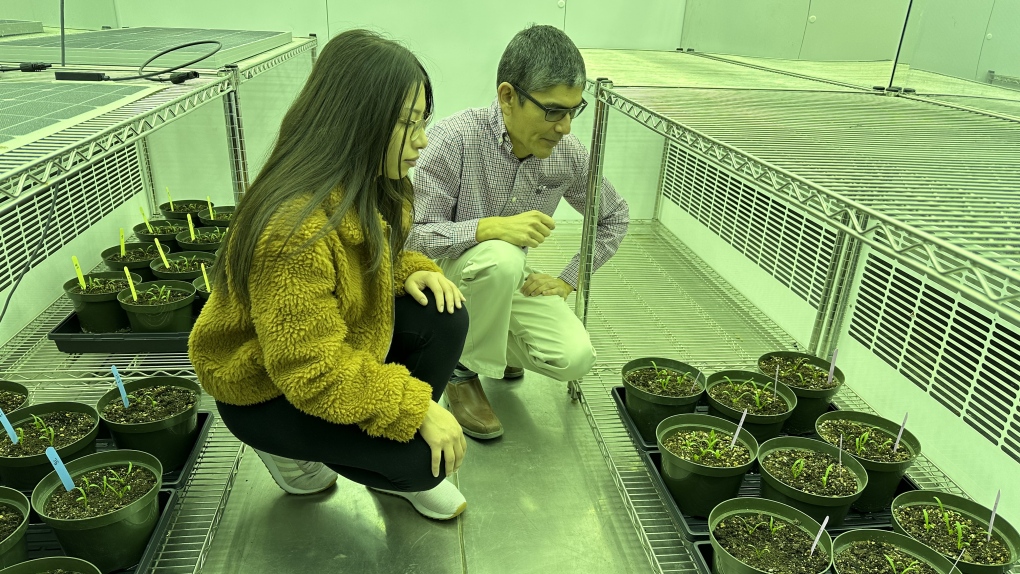'More connected': Researchers looking at growing food under solar panels
 Guillermo Hernandez, right, a soil scientist, and Camila Quiroz, a research intern from Peru, and look over their plants in a research room at the University of Alberta in Edmonton in this undated handout photo. (Guillermo Hernandez, University of Alberta
Guillermo Hernandez, right, a soil scientist, and Camila Quiroz, a research intern from Peru, and look over their plants in a research room at the University of Alberta in Edmonton in this undated handout photo. (Guillermo Hernandez, University of Alberta
Lawns, backyards and roofs could be used to produce both solar power and fresh vegetables, University of Alberta researchers say.
Guillermo Hernandez, a soil scientist, and Camila Quiroz, a research intern from Peru, are looking into growing crops under solar panels to improve the use of space in cities and farms.
"We know how to generate electricity from sunlight. We also know how to grow crops," says Hernandez. "But the question is, can we do the two things in the same space?"
Crop harvesting under solar panels is called agrivoltaics, a relatively new concept to improve land-use efficiency by producing energy and food in the same spot.
In a 25-day experiment, Hernandez and Quiroz grew batches of spinach under three systems — thick solar panels, thin solar panels and without solar panels.
The researchers used simulated sunlight in a small room at the university during the Alberta winter.
Quiroz, who is studying energy engineering in Peru, says there weren't any significant differences in taste or nutrition between the spinach grown under solar panels and the batch grown under simulated sunlight.
"I ate some of the solar panel-grown spinach," Quiroz says. "They were sweet. The taste was perfect."
However, the solar panel-grown plants were smaller than the batch grown without the panels.
Quiroz says a "little more time" under the panel would help them mature better.
The researchers are conducting a lab analysis to determine the exact nutritional composition of the three batches, and will be publishing the results in the coming weeks.
Quiroz says agrivoltaics is about more than just optimizing land area.
Solar panels create a microclimate underneath them, shielding plants from direct sunlight and fostering the right temperatures. Greens, berries and broccoli are among the foods that grow well under solar panels.
Quiroz says solar panels could also contribute to higher crop production for certain foods and improve water efficiency.
"Another benefit is the increase the solar energy generation," Quiroz says.
An International Energy Agency report this year said investors are increasingly gravitating towards solar-powered projects, outpacing the spending on fossil fuel projects for the first time.
Hernandez says even though the initial cost of installing solar panels could be high, agrivoltaics has the potential to become a part of the urban landscape in Canada.
"The connection with food is missing in some urban areas."
He says agrivoltaic farming would teach people to grow fresh produce while harnessing solar energy on balconies, backyards and smaller areas.
"People will be able to witness growing their own food, and they will feel more connected to where their food is coming from."
Some provincial governments have been giving rebates and grants to households and institutions for installing solar panels.
Other countries, including South Korea and France, are also experimenting with agrivoltaics.
Hernandez says the next step is to secure funding for research on other vegetables and explore how solar panels work outdoors and at differing heights and angles.
He is also working on a guide for agrivoltaic farming, which would include a list of crops that can be grown under solar panels.
This report by The Canadian Press was first published May 27, 2023
CTVNews.ca Top Stories

Canada expands list of banned firearms to include hundreds of new models and variants
The Canadian government is expanding its list of banned firearms, adding hundreds of additional makes, models and their variants, effective immediately.
Could the discovery of an injured, emaciated dog help solve the mystery of a missing B.C. man?
When paramedic Jim Barnes left his home in Fort St. John to go hunting on Oct. 18, he asked his partner Micaela Sawyer — who’s also a paramedic — if she wanted to join him. She declined, so Barnes took the couple’s dog Murphy, an 18-month-old red golden retriever with him.
The world has been warming faster than expected. Scientists now think they know why
Last year was the hottest on record, oceans boiled, glaciers melted at alarming rates, and it left scientists scrambling to understand exactly why.
The latest: Water bottle, protein bar wrapper may help identify shooter in UnitedHealthcare CEO's killing
The masked gunman who stalked and killed UnitedHealthcare CEO Brian Thompson used ammunition emblazoned with the words 'deny,' 'defend' and 'depose,' a law enforcement official said Thursday. Here's the latest.
7.0 earthquake off Northern California prompts brief tsunami warning
A 7.0 magnitude earthquake shook a large area of Northern California on Thursday, knocking items off grocery store shelves, sending children scrambling under desks and prompting a brief tsunami warning for 5.3 million people along the U.S. West Coast.
Saskatoon based dog rescue operator ordered to pay $27K for defamatory Facebook posts
A Saskatoon based dog rescue operator has been ordered to pay over $27,000 in damages to five women after a judge ruled she defamed them in several Facebook posts.
Pete Davidson, Jason Sudeikis and other former 'SNL' cast members reveal how little they got paid
Live from New York, it's revelations about paydays on 'Saturday Night Live.'
Vancouver Mayor Ken Sim admits to being 'orange pilled' in Bitcoin interview
Bitcoin is soaring to all-time highs, and Vancouver Mayor Ken Sim wants the city to get in on the action.
Man wanted for military desertion turns himself in at Canada-U.S. border
A man wanted for deserting the U.S. military 16 years ago was arrested at the border in Buffalo, N.Y. earlier this week.

































